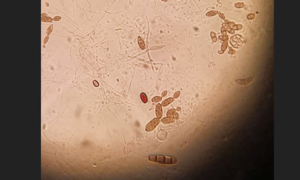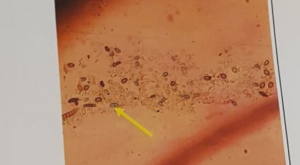Neonectra ditissima 03.05.2021
Fruit tree cancer
NIBIO have traps for the spores that rotate with 1 mm every half an hour. So when I look at the preparations in the microscope I count how many spores I can see in my field of sight for every 2 mm horizontally going up or down while I am counting. This gives a chart that tells us how many spores are released every our in a day.
First thing is to get to know what these spores look like as there are many spores that look kind of the same. So, I have been given a preparate that has been counted earlier and then we tracked the spores with the location that has been written down earlier. The spores we are looking for have a cleft in the middle widest section that is quite distinguishable.
Figure 1: Picture given to me to illustrate what the spores from Neonectria ditissima looks like. Yellow arrow point to one spore.
Figure 2: Picture I have taken myself with my phone through the microscope. There is a bundle of the Neonectria ditissima spores in the middle of this picture. A little down to the right of the red/brownish spore you can see 4 spores that clearly have this single cleft in the middle widest part.
Working like a scientist is a bit like working as a detective. Something has usually happened, and someone wants answers. What I am working with here at NIBIO now feels a bit like finding a perpetrator. I am looking for spores from the fungi Neonectria ditissima (fruit tree cancer) in preperate’s made from traps. We are also going to visit some fruit tree fields to look for the fruiting body of the fungi Chondrostereum purpureum (sølvglans).
We are looking to find spores because they want to chart when the fungi release its spores. Hypothesis is that it releases spores in weather that is over 0 degrees Celsius and when its wet (there is precipitation). With milder winters and wetter summers due to changing climate there has been an increase in amount of fruit trees that are infected by fruit tree cancer.
Fruit tree cancer is a fungi infection (which I find the name a little unjust) that can give an adult tree what looks like cancerous tumours. Fruit tree’s that usually get infected are apple and pear tree’s but they can also infect other hardwood tree’s.
